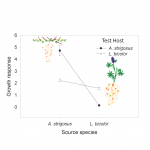 Specialization-Generalization Trade-off in a Bradyrhizobium Symbiosis with Wild Legume Hosts
Specialization-Generalization Trade-off in a Bradyrhizobium Symbiosis with Wild Legume Hosts
Abstract
Specialized interactions help structure communities, but generalist can occupy more environments and partake in more beneficial interactions. So, why do specialists persist? The “Jack-of-all-trades is a master of none” hypothesis seeks to explain specialists by asserting that the fitness of a generalist utilizing a particular habitat is lower than that of a specialist adapted to that habitat. Yet, there are many reasons to expect that mutualists will generalize on partners.
We tested for specialist-generalist trade-offs by quantifying realized partner richness and phylogenetic breadth of four wild-grown native legumes (Lupinus bicolor, L. arboreus, Acmispon strigosus and A. heermannii) and performing inoculation trials to test the ability of two hosts (L. bicolor and A. strigosus) to nodulate (fundamental partner richness), benefit from (response specificity), and provide benefit to (effect specificity) 31 Bradyrhizobium genotypes.
Results
In the wild, each Lupinus species hosted a broader genetic range of Bradyrhizobium than did either Acmispon species, suggesting that Acmispon species are more specialized. In the greenhouse, however, L. bicolor and A. strigosus did not differ in fundamental association specificity: all inoculated genotypes nodulated both hosts. Nevertheless, A. strigosus exhibited more specificity, i.e. greater variation in its response to, and effect on, Bradyrhizobium genotypes. Lupinus bicolor benefited from a broader range of genotypes but averaged less benefit from each. Both hosts obtained more fitness benefit from symbionts isolated from conspecific hosts; those symbionts in turn gained greater fitness benefit from hosts of the same species from which they were isolated.
Conclusions
This study affirmed two important tenets of evolutionary theory. First, as predicted by the Jack-of-all-trades is a master of none hypothesis, specialist A. strigosus obtained greater benefit from its beneficial symbionts than did generalist L. bicolor. Second, as predicted by coevolutionary theory, each test species performed better with partner genotypes isolated from conspecifics (see figure, above). Finally, positive fitness feedback between the tested hosts and symbionts suggests that positive plant-soil feedback could contribute to their patchy distributions in this system.
